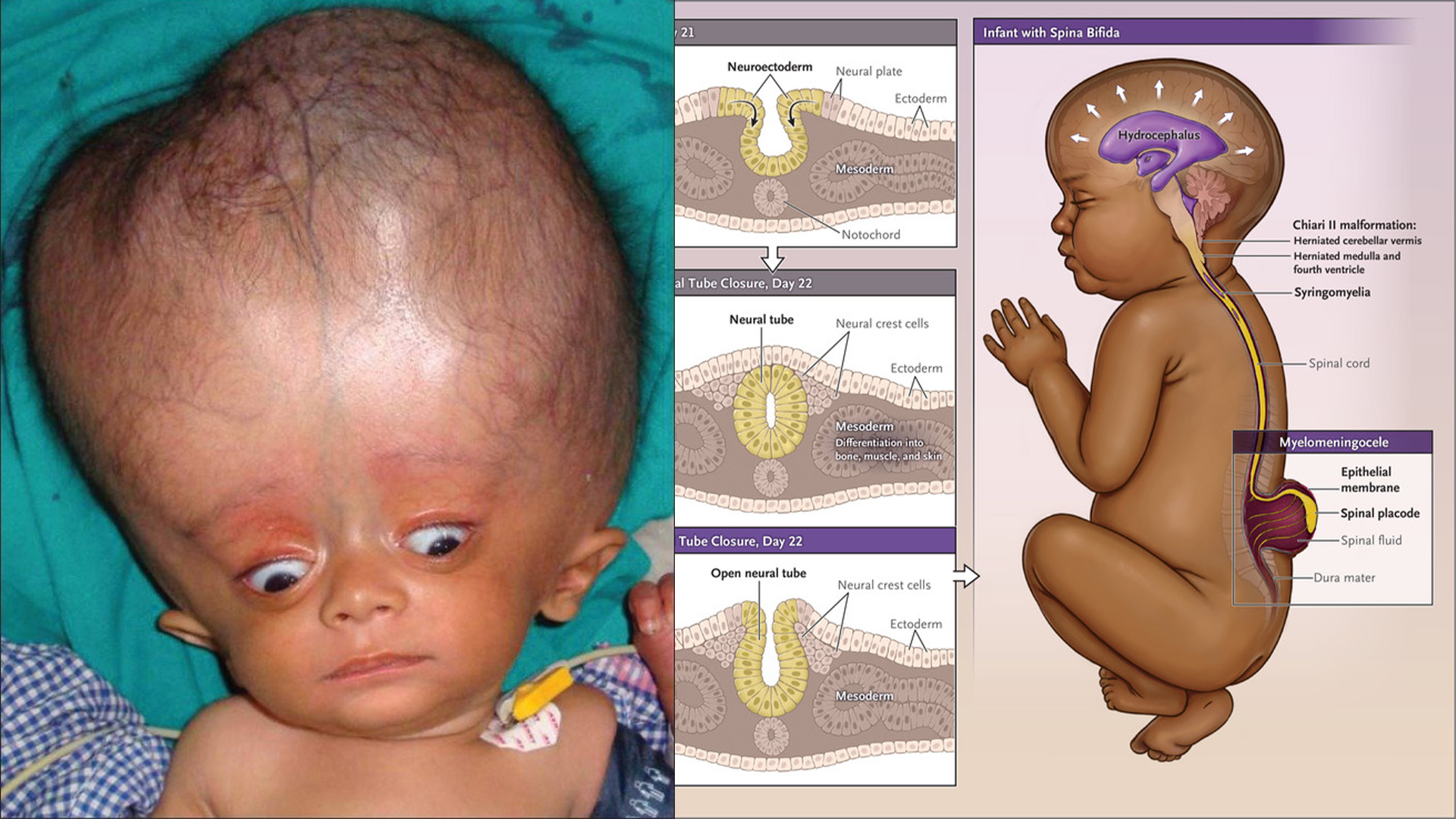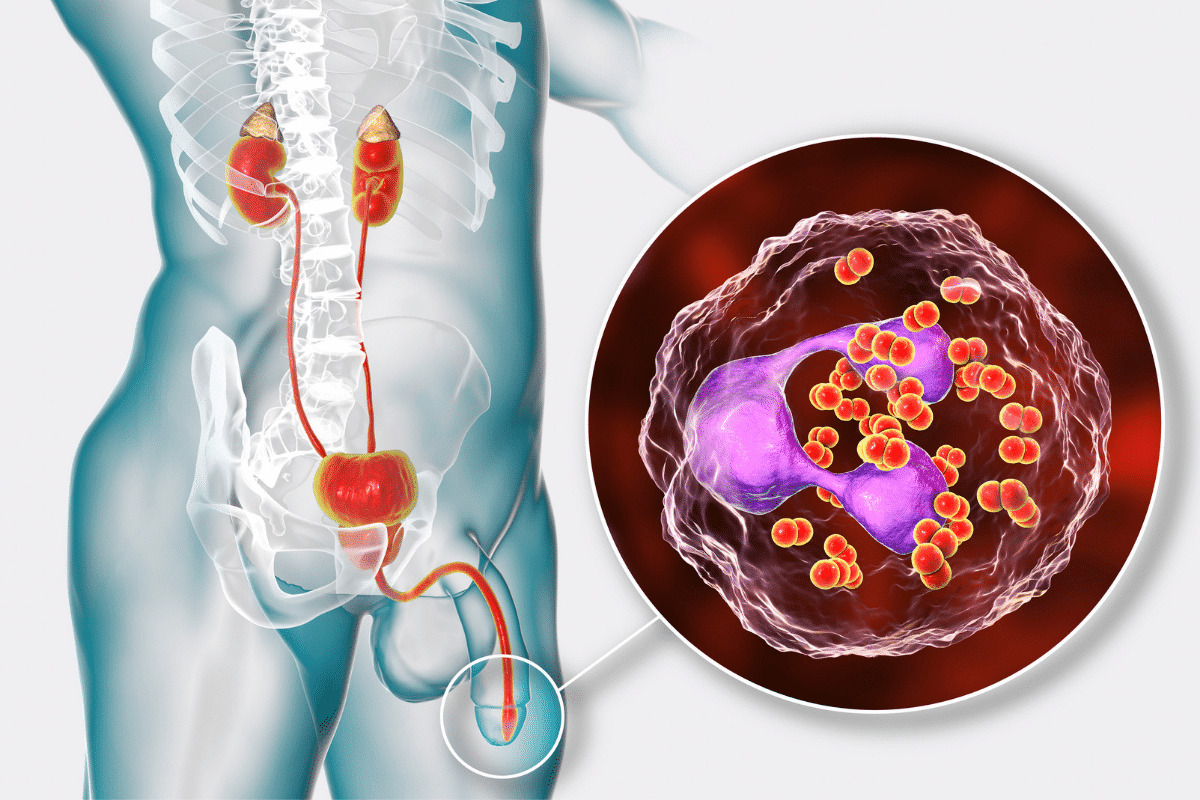
Spina bifida is a neural tube defect occurring early during fetal development, in which part of one or more of the bones of the spine (vertebrae) fail to develop completely, leaving a portion of the spinal cord exposed and resulting in damage to exposed nerve tissue.
Hydrocephalus is a condition in which there is abnormal accumulation of cerebrospinal fluid in the skull, causing increased pressure on the brain.
Spina bifida
Typically, the neural tube forms early in pregnancy and it closes by the 28th day after conception. In babies with spina bifida, a portion of the neural tube doesn’t close or develop properly, causing problems in the spinal cord and in the bones of the spine
Spina bifida can range from mild to severe, depending on the type of defect, size, location and complications. When necessary, early treatment for spina bifida involves surgery — although such treatment doesn’t always completely resolve the problem.
The most common types of spina bifida
Spina bifida (myelomeningocele)
Myelomeningocele is a severe type of spina bifida in which the membranes and the spinal nerves protrude at birth, forming a sac on the baby’s back. The exposed nervous system may become infected, so prompt surgery is needed after birth.
Spina bifida occulta
Occulta means hidden. It’s the mildest and most common type. Spina bifida occulta results in a small separation or gap in one or more of the bones of the spine (vertebrae). Many people who have spina bifida occulta don’t even know it, unless the condition is discovered during an imaging test done for unrelated reasons.
Myelomeningocele
Also known as open spina bifida, myelomeningocele is the most severe type. The spinal canal is open along several vertebrae in the lower or middle back. The membranes and spinal nerves push through this opening at birth, forming a sac on the baby’s back, typically exposing tissues and nerves. This makes the baby prone to life-threatening infections and may also cause paralysis and bladder and bowel dysfunction.
Meningocele
This rare type of spina bifida is characterized by a sac of spinal fluid bulging through an opening in the spine. No nerves are affected in this type, and the spinal cord isn’t in the fluid sac. Babies with meningocele may have some minor problems with functioning, including those affecting the bladder and bowels.
Symptoms
Signs and symptoms of spina bifida vary by type and severity, and also between individuals.
-
- Spina bifida occulta. Typically, there aren’t any signs or symptoms because the spinal nerves aren’t involved. But you can sometimes see signs on the newborn’s skin above the spinal problem, including a tuft of hair, a small dimple or a birthmark. Sometimes, these skin marks can be signs of an underlying spinal cord issue that can be discovered with MRI or spinal ultrasound in a newborn.
-
- Meningocele. This type may cause problems with bladder and bowel function.
-
- Myelomeningocele. In this severe type of spina bifida:
-
- The spinal canal remains open along several vertebrae in the lower or middle back
-
- Both the membranes and the spinal cord or nerves protrude at birth, forming a sac
-
- Tissues and nerves usually are exposed, though sometimes skin covers the sac
-
- Myelomeningocele. In this severe type of spina bifida:
Causes
Doctors aren’t certain what causes spina bifida. It’s thought to result from a combination of genetic, nutritional and environmental risk factors, such as a family history of neural tube defects and folate (vitamin B-9) deficiency.
Risk factors
Although doctors and researchers don’t know for sure why spina bifida occurs, they have identified some risk factors:
-
- Folate deficiency. Folate, the natural form of vitamin B-9, is important to the development of a healthy baby. The synthetic form, found in supplements and fortified foods, is called folic acid. A folate deficiency increases the risk of spina bifida and other neural tube defects.
-
- Family history of neural tube defects. Couples who’ve had one child with a neural tube defect have a slightly higher chance of having another baby with the same defect. That risk increases if two previous children have been affected by the condition. In addition, women who were born with a neural tube defect have a greater chance of giving birth to a child with spina bifida than someone who doesn’t have a neural tube defect. However, most babies with spina bifida are born to parents with no known family history of the condition.
-
- Some medications. For example, anti-seizure medications, such as valproic acid seem to cause neural tube defects when taken during pregnancy. This might happen because they interfere with the body’s ability to use folate and folic acid.
-
- Diabetes. Women with diabetes who don’t have well-controlled blood sugar have a higher risk of having a baby with spina bifida.
-
- Obesity. Pre-pregnancy obesity is associated with an increased risk of neural tube birth defects, including spina bifida.
-
- Increased body temperature. Some evidence suggests that increased body temperature (hyperthermia) in the early weeks of pregnancy may increase the risk of spina bifida. Increases in core body temperature, due to fever or use of a sauna or hot tub, have been associated with a slightly increased risk of spina bifida.
If you have known risk factors for spina bifida, talk with your doctor to determine if you need a larger dose or prescription dose of folic acid, even before a pregnancy begins.
Hydrocephalus
Hydrocephalus is the buildup of cerebrospinal fluid (CSF) within the brain’s hollow spaces (ventricles). The excessive fluid increases pressure inside the skull, affecting the brain’s ability to function normally.
Types of Hydrocephalus
Hydrocephalus can occur at any age but is most common in babies and older adults. The two main types are:
-
- Noncommunicating (obstructive) hydrocephalus develops when a blockage occurs along one or more of the passages connecting the ventricles. As a result, CSF cannot flow freely among the ventricles.
-
- Communicating hydrocephalus occurs when CSF cannot adequately be reabsorbed into the bloodstream. It’s called “communicating” because the CSF can still flow normally within the ventricles.
Hydrocephalus is also sometimes categorized as congenital or acquired hydrocephalus. Congenital hydrocephalus is present at birth, whereas acquired hydrocephalus develops after birth.
The following two forms of acquired hydrocephalus can develop in adults:
-
- Normal pressure hydrocephalus (NPH) is a communicating hydrocephalus that can strike at any age but is more common in adults 60 or older. It’s characterized by widened ventricles but normal CSF pressure.
-
- Hydrocephalus ex vacuo is usually seen in older individuals. It develops when the brain tissue surrounding the ventricles shrinks. CSF volume increases within the ventricles to try and fill the extra space.
Hydrocephalus Symptoms
Hydrocephalus symptoms often occur due to increased pressure within the skull (increased intracranial pressure).
National Organization of Rare Diseases. Hydrocephalus.
In congenital hydrocephalus, symptoms may include:
-
- A head that is larger than normal
-
- A bulge at the soft spot on top of the head (fontanelle)
-
- Eyes that stay looking down
-
- Vomiting
-
- Problems feeding
-
- Sleepiness or unusual fussiness
In older children and adults, hydrocephalus symptoms include:
-
- Headache (usually worse when lying down, coughing, or having a bowel movement)
-
- Vision problems (e.g., double vision)
-
- Nausea or vomiting
-
- Poor balance or coordination
-
- Drowsiness
-
- Loss of previously acquired skills (e.g., walking)
-
- Change in personality or behavior
Causes of hydrocephalus
-
- Hydrocephalus has many potential causes, depending on the type.
-
- Congenital hydrocephalus can be caused by inherited genetic abnormalities or developmental disorders affecting the brain’s CSF flow.
-
- Acquired hydrocephalus in babies is most commonly caused by a brain bleed, often due to prematurity.
-
- Other causes of hydrocephalus in babies include:
-
- Brain tumor or infection, usually bacterial meningitis (infection of the membranes that surround the brain/spinal cord)
-
- Unrecognized infections during pregnancy (e.g., cytomegalovirus (CMV) or toxoplasmosis)
-
- Exposure to certain medications during pregnancy (e.g., misoprostol)
-
- Normal pressure hydrocephalus may be caused by a brain bleed or tumor, head trauma, or meningitis. In around half of NPH cases, the cause remains unknown.6
-
- Hydrocephalus ex-vacuo is usually caused by a stroke or an injury to the brain. It may also occur in older individuals whose brain shrinks with age or in those with Alzheimer’s disease.
The diagnosis of hydrocephalus involves a brain imaging test, like an ultrasound or MRI. Treatment consists of brain surgery, typically placing a shunt in the brain to drain the excess CSF
Conclusion
Due to the reduced mobility, children, adolescents and adults with spina bifida will be at increased risk of obesity. Combined with the lack of sensation, there is a the risk of skin breakdown and pressure ulcers. A healthy lifestyle and diet are key, as are regular skin checks.
In some cases, spina bifida and/or hydrocephalus may result in impaired cognitive development and learning disabilities, yet many children born with these conditions have a normal IQ and will attend regular classes. Others may need assistance to maximise their learning capacity.




